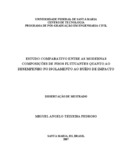| dc.creator | Pedroso, Miguel Angelo Teixeira | |
| dc.date.accessioned | 2009-03-10 | |
| dc.date.available | 2009-03-10 | |
| dc.date.issued | 2007-12-20 | |
| dc.identifier.citation | PEDROSO, Miguel Angelo Teixeira. A comparative study between modern compositions of floating floors in terms of the performance in the impact noise isolation. 2007. 141 f. Dissertação (Mestrado em Engenharia Civil) - Universidade Federal de Santa Maria, Santa Maria, 2007. | por |
| dc.identifier.uri | http://repositorio.ufsm.br/handle/1/7688 | |
| dc.description.abstract | The impact noise is a challenge to builders and designers because of the difficulty in the interruption of vibrations due to the rigidity of the connections between the structural elements. Many previous researches aimed at the development of methods to diminish its effects and among them the floating floor , constituted by the interposition of an elastic material between the flagstone and the final covering of the floor, has presented significant advantages in presenting a solution still in the project phase. The introduction of new materials in the market made it possible the development of this study, whose objectives were to measure and to compare the performance of these materials as isolators, as well as to determine the relative advantage to the cost/benefit criterion in the construction of systems with porcelanate and plated melamínico wooden final coverings, and the utilization of glass wool, recycled blankets of rubber (E.V.A. residues) and high density Styrofoam and polyethylene blanket as resilient materials. The experiments carried out at the Thermo-acoustic laboratory (LaTA) in the university, according to the methodology suggested by ISO 140/VI and VIII (except the specifications as to the size of the samples that were tested with 1m ²) and ISO 717-2, permitted the classification of the tested materials in terms of their performance while impact noise acoustic isolators, and the market research made it possible to establish a hierarchy in the cost/benefit aspect. | eng |
| dc.format | application/pdf | por |
| dc.language | por | por |
| dc.publisher | Universidade Federal de Santa Maria | por |
| dc.rights | Acesso Aberto | por |
| dc.subject | Isolamento acústico | por |
| dc.subject | Ruído de impacto | por |
| dc.subject | Pisos flutuantes | por |
| dc.subject | Acoustic isolation | eng |
| dc.subject | Impact noise | eng |
| dc.subject | Floating floors | eng |
| dc.title | Estudo comparativo entre as modernas composições de pisos flutuantes quanto ao desempenho no isolamento ao ruído de impacto | por |
| dc.title.alternative | A comparative study between modern compositions of floating floors in terms of the performance in the impact noise isolation | eng |
| dc.type | Dissertação | por |
| dc.description.resumo | O ruído de impacto é um desafio para construtores e projetistas pela dificuldade que se encontra para a interrupção das vibrações decorrentes da rigidez dos vínculos entre os elementos estruturais. Diversos estudos científicos visaram o desenvolvimento de métodos para amenizar seus efeitos, dos quais o piso flutuante , composto pela interposição de material elástico entre a laje e o revestimento final, tem apresentado vantagens significativas porque apresenta a solução ainda na fase do projeto. O surgimento de novos materiais no mercado ensejou a realização deste trabalho que teve como objetivo medir e comparar o desempenho desses materiais como isolantes, além de determinar a vantagem relativa no critério custo/benefício, na montagem de sistemas com revestimentos finais de porcelanato e laminado melamínico de madeira, e a utilização de lã de vidro, mantas de borracha reciclada (resíduos de E.V.A.), isopor de alta densidade e manta de polietileno como materiais resilientes. Os ensaios realizados no Laboratório de Termo-Acústica (LaTA) da UFSM de acordo com a metodologia preconizada pelas ISO 140/VI e VIII (exceto as especificações quanto ao tamanho das amostras que foram testadas com 1m²) e ISO 717-2 permitiram escalonar os materiais testados quanto aos seus desempenhos como isolantes acústicos ao ruído de impacto e a pesquisa mercadológica possibilitou determinar uma hierarquização no aspecto custo/benefício. | por |
| dc.contributor.advisor1 | Santos, Jorge Luiz Pizzutti dos | |
| dc.contributor.advisor1Lattes | http://lattes.cnpq.br/9959263691618620 | por |
| dc.contributor.referee1 | Paixão, Dinara Xavier da | |
| dc.contributor.referee1Lattes | http://lattes.cnpq.br/3967266929672774 | por |
| dc.contributor.referee2 | Miranda, Erasmo Felipe Vergara | |
| dc.contributor.referee2Lattes | http://lattes.cnpq.br/1682598720803230 | por |
| dc.publisher.country | BR | por |
| dc.publisher.department | Engenharia Civil | por |
| dc.publisher.initials | UFSM | por |
| dc.publisher.program | Programa de Pós-Graduação em Engenharia Civil | por |
| dc.subject.cnpq | CNPQ::ENGENHARIAS::ENGENHARIA CIVIL | por |


